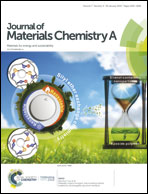A biomimetic multifunctional electronic hair sensor†
Abstract
A high performance electronic hair (EH) sensor with multiple responsibilities is fabricated via fully mimicking the sensory hair cell structure and properties of human skin. The designed EH sensor consists of nylon fibers as hairs for mechanical signal amplification and polydimethylsiloxane (PDMS) resin as the human skin for sensor encapsulation. Two carbonized papers are used as piezo-resistive mechanoreceptors (M1 and M2). The nylon fibers used have a diameter and Young's modulus close to those of hairs and PDMS has a Young's modulus close to that of human skin. The structure of human hairs is verified to be optimal for maximizing the sensing ability, and the structure of the EH sensor is then optimized in terms of the structure of human hairs. Unlike conventional single-mode EH sensors, the EH sensor obtained by fully mimicking human skin is capable of detecting multiple signals of pressure, surface roughness, the airflow rate, etc. just like human skin. Moreover, the EH sensor is also effective in identifying the airflow direction. Because of its simple structure, low cost, good flexibility and multiple functionalities, the EH sensor is expected to find widespread application in e-skins, wearable devices, robotics, human machine interfaces, etc.



 Please wait while we load your content...
Please wait while we load your content...